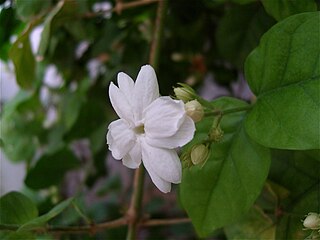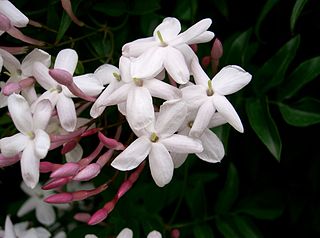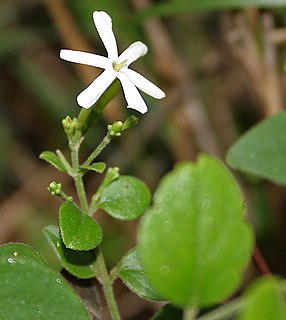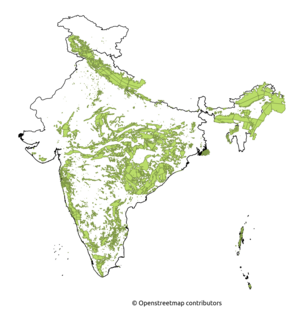
The Andaman and Nicobar Islands, a union territory of India, are a group of 836 objects, with 572 of them islands, of which 38 are inhabited at the juncture of the Bay of Bengal and the Andaman Sea.

Jasmine is a genus of shrubs and vines in the olive family (Oleaceae). It contains around 200 species native to tropical and warm temperate regions of Eurasia and Oceania. Jasmines are widely cultivated for the characteristic fragrance of their flowers. A number of unrelated plants contain the word "jasmine" in their common names.

Narcondam, India's easternmost Island, is a small volcanic island located in the northern Andaman Sea. The island's peak rises to 710 m above mean sea level, and it is formed of andesite. It is part of the Andaman Islands, the main body of which lie approximately 124 km (77 mi) to the west. The island is part of the Indian union territory of Andaman and Nicobar Islands. The island is small, covering an area of approximately 6.8 square kilometres. It was classified as a dormant volcano by the Geological Survey of India.
Saddle Peak National Park is a national park in the Andaman and Nicobar Islands in India. It was set up in 1979.
Galathea National Park is a National Park located in the Union Territory of Andaman and Nicobar Islands, India. It is located on the island of Great Nicobar in the Nicobar Islands, which lie in the eastern Indian Ocean.

Mount Harriet National Park is a national park located in the Andaman and Nicobar Islands union territory of India. The park, established in 1969, covers about 4.62 km2 (18.00 mi2). Mount Harriet, which is part of the park, is the third-highest peak in the Andaman and Nicobar archipelago next to Saddle Peak in North Andaman and Mount Thullier in Great Nicobar.

Jasminum sambac is a species of jasmine native to tropical Asia, from the Indian subcontinent to Southeast Asia. It is cultivated in many places, especially across much of South and Southeast Asia. It is naturalised in many scattered locales: Mauritius, Madagascar, the Maldives, Christmas Island, Chiapas, Central America, southern Florida, the Bahamas, Cuba, Hispaniola, Jamaica, Puerto Rico, and the Lesser Antilles.

Jasminum polyanthum, the many-flowered jasmine or pink jasmine, is a species of flowering plant in the olive family Oleaceae, native to China and Myanmar. A strong evergreen twining climber, it is especially noted for its abundant, highly fragrant pink to white flowers.

Bentinckia nicobarica is a species of flowering plant in the family Arecaceae found to occur in the Nicobar group of islands in the Bay of Bengal. It is an endemic palm occurring in Great Nicobar, Katchal, Nancowry and Car Nicobar Islands.

Phoenix andamanensis is a wild relative of date palm endemic to the Andaman Islands in the Bay of Bengal southwest of Myanmar. It is rather a newly described taxon by Sasha C. Barrow in 1998 based on old herbarium collections. This taxon was known only from a few herbarium collections and a few insignificant citations by Kurz in 1870, Brandis in 1906 and Parkinson in 1923. The Herbarium collections were made mostly during the British regime in 1903, 1904 and 1911 by Rogers and Osmaton. Later, Ellis from the Botanical Survey of India in 1990 collected one specimen from the Saddle Peak. The specimens were remained unidentified at herbaria until its circumscription as new taxon by Barrow in 1998.

Jasminum auriculatum is a species of jasmine, in the family Oleaceae. It is found in India, Nepal, Sri Lanka, Bhutan and the Andaman Islands. Due to essential oil contained in the flowers, it cultivated commercially in India and Thailand. It is used for decorative purposes and festivals in India. It is commonly called "JUI"(ଯୁଇ, জুই) in India in Odia and Bengali languages.
Vanilla andamanica is an endangered wild relative of commercial vanilla, Vanilla planifolia, the source of Vanilla essence. It grows in the Andaman and Nicobar Islands, India in the Bay of Bengal., and classified as a Vulnerable species (VU) by the IUCN Red List.

Tropical Evergreen forests of India are found in the Andaman and Nicobar Islands, as
Western Ghats, which fringe the Arabian Sea, the coastline of peninsular India, and the greater Assam region in the north-east. Small remnants of evergreen forest are found in Odisha state. Semi-evergreen forest is more extensive than the evergreen formation partly because evergreen forests tend to degrade to semi-evergreen with human interference. There are substantial differences between the three major evergreen forest regions.

Jasminum azoricum, the lemon-scented jasmine, is a species of flowering plant in the olive family. It is an evergreen twining vine native to the Portuguese island of Madeira. The compound leaves consist of 3 bright green leaflets. The fragrant white star-shaped flowers appear in panicles from the leaf axils in summer, evolving from deep pink buds.

Jasminum angustifolium, the wild jasmine, is a species of jasmine native to India, Sri Lanka and the Andaman Islands. It is a climbing shrub with a smooth stem and minutely pubescent branchlets. The flowers are approximately 1 inch in diameter, and resemble a star with 7 or 8 narrow petals, flowering between June and August.
Piper ribesioides, also known as Lao chili wood, mai sakhaan, sankhaan, sankharn, sankahn or sakahn is a species of black pepper plant. The woody vine or stem of the plant has a hot, peppery and chili flavour, with a lingering aftertaste and slightly numbing sensation to the tongue. It is commonly used in Lao cuisine both in Laos and the predominately Lao ethnic region of Northeastern Thailand. It is the most important ingredient in Laos' famous Or lam. Its berries are sometimes pressed for an oil that is also used in cooking.
Ficus punctata is a lesser-known climbing liana reported from Myanmar, the Andaman-Nicobar Archipelago, Thailand, Indochina, Malaysia, and Indonesia with remarkable ornamental value. It is a handsome woody liana with spectacular spotted orange fruits. This taxon occurs in disturbed forests and rarely along the edges of the evergreen forests. This species has remarkable ornamental value and can be introduced in gardens. This Ficus can be identified in the field by its climbing habit, presence of milky latex, rhomboidal obovate coriaceious leaves, and beautiful spotted crimson-orange fruits.
Cryptocarya caesia is a tree in the family Lauraceae reported from Java Island in Indonesia and the Andaman Islands in the Bay of Bengal. This species was originally described by Blume from Java in 1851. Later, in 1884, George King located this tree in Port Blair in the Andaman Islands and collected some herbarium specimens.

Hugonia mystax is a species of plant in the family Linaceae found mainly in the dry forests of peninsular India and Sri Lanka. It is a scandent shrub, sometimes growing liana-like over other trees and bears yellow flowers and orange to red fruits in the rainy season. The branchlets are leafless at the base and instead have a pair of recurved spines which bear a resemblance to a moustache, giving rise to the epithet mystax, Latin for moustache.
A large, very high liana, or climbing tree in the Arecaceae palm family, Korthalsia laciniosa occurs in the closed forests of Java, Sumatra, the Philippines, Malay Peninsula, Vietnam, Cambodia and elsewhere in Indochina, and the Nicobar and Andaman Islands. The palm usually grows in lowland forests, often close to the coast, however on the Malay peninsula it has been observed growing in hill Dipeterocarp forests up to 1000m elevation. It occurs in clumps of 4 to 20 individual stems, up to 7.2m high, in the tropical and subtropical monsoon rain evergreen forests of Bạch Mã National Park in Thừa Thiên-Huế Province, central Vietnam. It is described as a common species in the Andaman Islands, growing in the moist semi-evergreen and deciduous forests belt. Senthilkumar et al. however found it abundant in South Andaman, less common in Middle and North Andaman, and not common in the Nicobar Islands.












